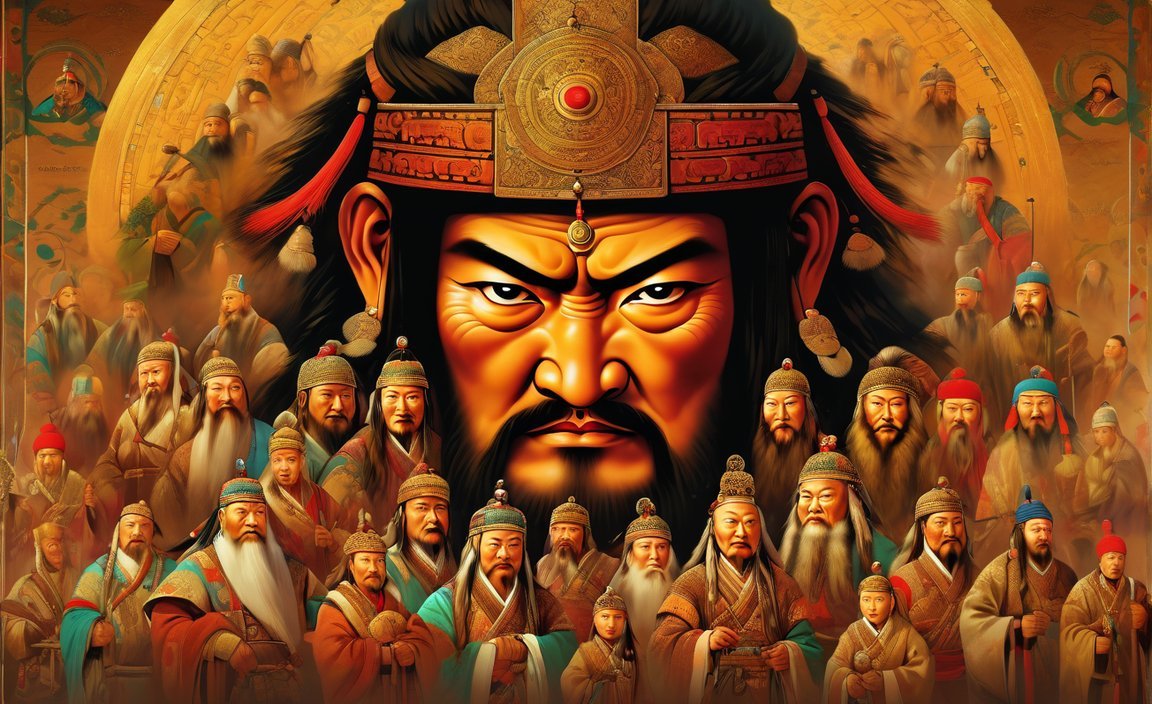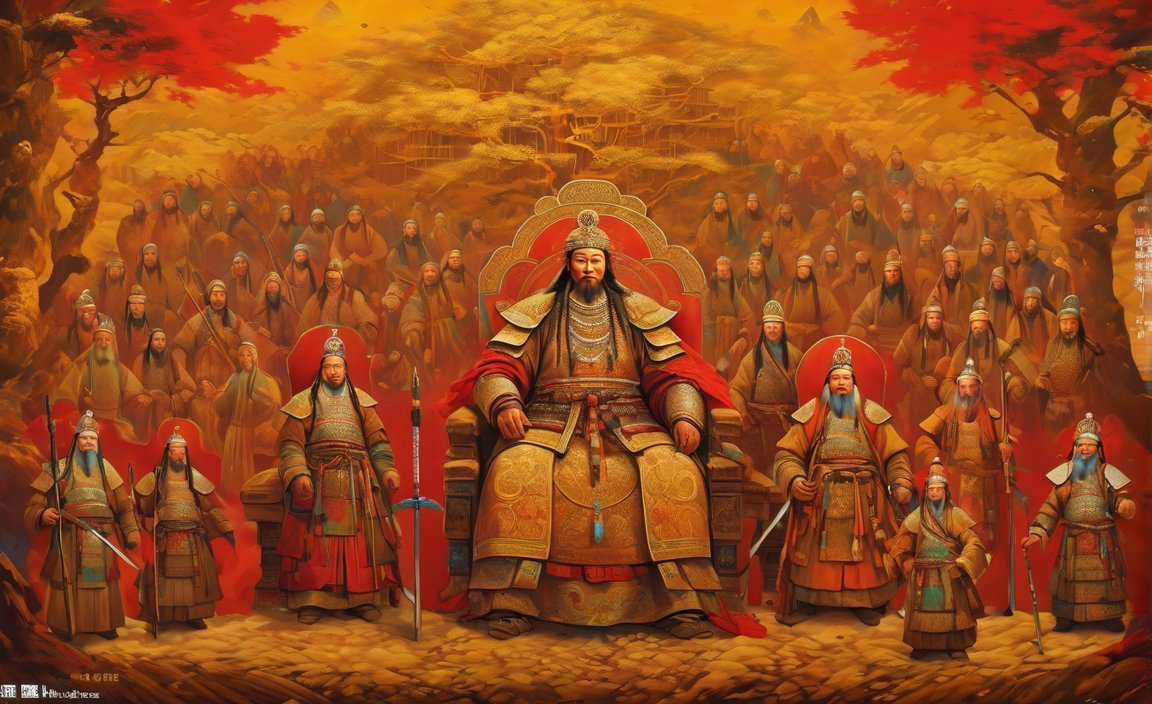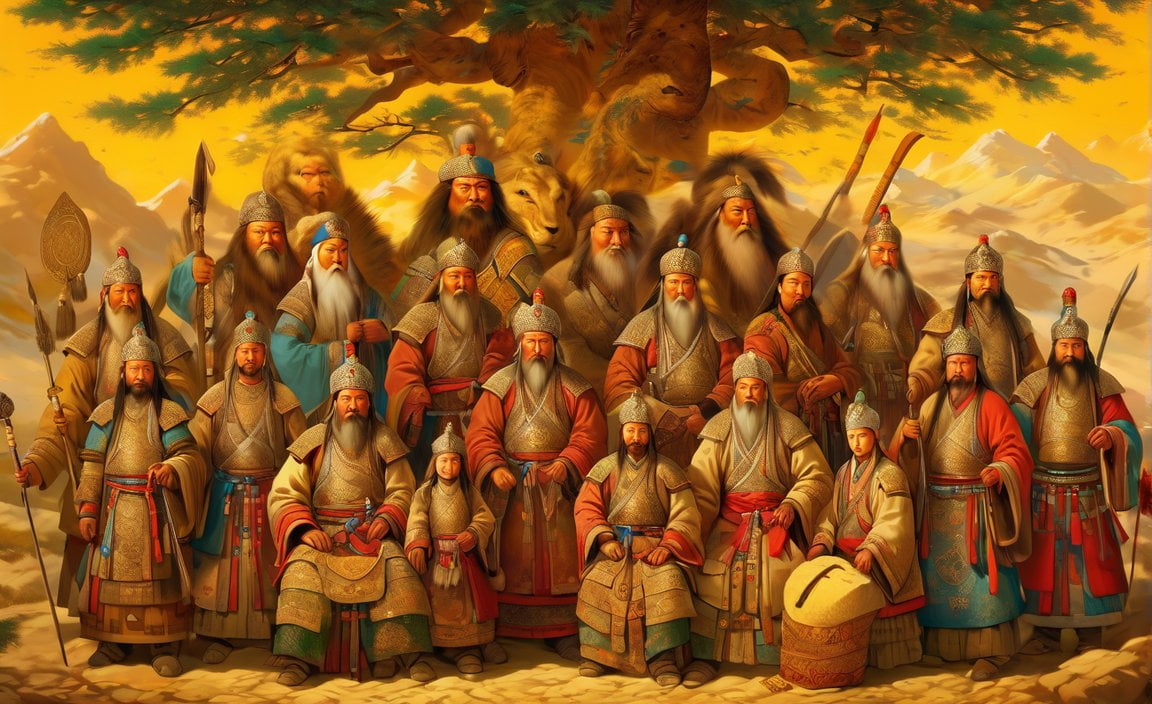Unravel the fascinating tale of the Mongol Empire’s legendary founder, Genghis Khan, and his sprawling family tree. Join us on a journey to unravel the identities of his sons and their remarkable roles in building the empire. We’ll also connect the dots between the royal family and their modern-day descendants, revealing the incredible legacy that continues to captivate historians and ignite curiosity in all who seek to explore the intricate tapestry of human history.

Genghis Khan Family Tree
Hidden within the pages of history lies a family story as fascinating as it is complex – the family tree of Genghis Khan. We’re talking about a man who transformed from a simple boy named Temüjin, orphaned at a young age, into the mighty Genghis Khan, the founder of the vast Mongol Empire. His conquests swept across continents, leaving a mark that still echoes today. And at the heart of this legacy lies his expansive and fascinating family.
Wives, Children, and a Legacy: Genghis Khan, like many powerful rulers of his time, had multiple wives and concubines. His most important wife, Borte, was the mother of his four sons: Jochi, Chagatai, Ögedei, and Tolui. These four weren’t just sons; they were key players in expanding and running the massive Mongol Empire.
Genghis Khan’s own family history takes us to the nomadic Borjigin clan, who wandered the vast Mongolian steppes. His ancestors included notable figures like Borjigit Khabul Khan, and his mother, Hö’elun, played a pivotal role in shaping his early years.
The impact of Genghis Khan’s descendants extends far beyond his immediate family. Modern genetic studies suggest that a staggering number of men, perhaps close to 16 million worldwide, carry his Y-chromosome. This is a testament to a genetic legacy that has touched generations and continents.
The family tree of Genghis Khan is like a miniature version of the Mongol Empire’s rise and reign. Through his many descendants, Genghis Khan’s bloodline has left an undeniable mark on world history, influencing the demographics, cultures, and genetic makeup of populations across the globe.
But here’s the thing about history – it’s full of mysteries! While we know a lot about Genghis Khan’s family, there are still gaps in the story. New research and discoveries are always popping up, adding new branches and details to this already intricate family tree. It’s a reminder that history is a living, breathing thing, always open to interpretation and new revelations.
Who are the 4 sons of Genghis Khan?
Genghis Khan, the fearless leader who brought together the Mongol Empire, had four main sons who played pivotal roles in the empire’s expansion and administration.
- Jochi: The eldest son, Jochi, was granted authority over the westernmost territories of the empire, which would later evolve into the Golden Horde. However, historical debate surrounds Jochi’s true parentage, with some theories suggesting he may not have been Genghis Khan’s biological son.
- Chagatai: Known for his strict adherence to Mongol law and customs, Chagatai was entrusted with the governance of the Chagatai Khanate, a vast region encompassing parts of modern-day Uzbekistan, Kazakhstan, and Kyrgyzstan.
- Ögedei: As Genghis Khan’s chosen successor, Ögedei ascended to the title of Great Khan upon his father’s death. Ögedei’s rule marked a period of significant expansion for the Mongol Empire, witnessing its largest territorial reach, spanning from Eastern Europe to East Asia.
- Tolui: The youngest of the four, Tolui, held a prominent position as a trusted general. His lineage continued to wield significant influence, as he was the father of Kublai Khan, who would later establish the influential Yuan dynasty in China.
Here’s a table summarizing the sons and their legacies:
| Son | Territory/Role | Interesting Fact |
|---|---|---|
| Jochi | Ulus of Jochi (later the Golden Horde) | Paternity disputed |
| Chagatai | Chagatai Khanate (Central Asia) | Known for his strict adherence to Mongol law |
| Ögedei | Succeeded Genghis Khan as Great Khan | Oversaw the empire’s largest territorial expansion |
| Tolui | Father of Kublai Khan (founder of the Yuan dynasty) | Lineage continued to significantly influence Mongol history |
Genghis Khan’s sons were not merely handed titles; they were entrusted with vast territories and immense responsibilities, playing active roles in shaping the Mongol Empire. The uncertainty surrounding Jochi’s parentage adds a layer of intrigue to the family’s history, while Ögedei’s reign saw the empire reach its territorial peak. Tolui’s legacy endured through his son, Kublai Khan, highlighting the enduring impact of Genghis Khan’s bloodline.
It’s essential to acknowledge that historical interpretations can vary based on available sources. Research into the Mongol Empire is an ongoing field, and new discoveries may further illuminate the lives and legacies of these influential figures.
Are the Royal Family Related to Genghis Khan?
The sheer scale of Genghis Khan’s descendants is mind-boggling. Some scientists estimate that as many as 1 in 200 men alive today could be his direct descendants. This astonishing figure raises the question: Could the British royal family be among them?
Genghis Khan’s position as the powerful Khan of the Mongol Empire provided his offspring with positions of authority, allowing them to spread their genes far and wide. The Mongols’ vast conquests and practices, while a dark chapter in history, further solidified the dominance of Genghis Khan’s lineage.
While a direct link between Queen Elizabeth II and the steppes of Mongolia remains unproven, it’s a tantalizing possibility. Historical genetics is a field full of surprises, with new discoveries constantly reshaping our understanding of the past. The possibility of such a connection within royal bloodlines is an intriguing area for further exploration.
How do I know if I’m related to Genghis Khan?
The possibility of being related to Genghis Khan is a question that has likely crossed many minds. While tracing every family tree back centuries with absolute certainty is a monumental task, modern genetic testing, combined with historical research, offers intriguing insights.
Scientists have identified a specific Y-chromosome signature nearly identical to that which Genghis Khan likely possessed. This marker is passed down from father to son, much like a genetic family heirloom. It’s estimated that roughly 0.5% of men worldwide, approximately 1 in 200, carry this telltale marker.
Of course, possessing this marker doesn’t necessarily make one a direct descendant in the traditional sense. It’s more akin to a vast family reunion where attendees share a very distant common ancestor.
For those eager to explore their potential connection, companies like AncestrybyDNA provide DNA testing kits that can shed light on genetic ancestry. These tests can reveal if you share any genetic markers with famous historical figures, including Genghis Khan.
Traditional genealogical research also plays a crucial role. Delving into old records, piecing together family trees, and exploring historical accounts can provide a richer context for your genetic journey.
It’s important to remember that scientific understanding, particularly in genetics, is continuously evolving. What we know today might only be the tip of the iceberg.
In the wild, tigers roam as the undisputed kings of the jungle. But have you ever wondered, “What eats tigers?” Discover the surprising answer by clicking here to uncover the mysterious predators that prey on these powerful felines.
When exploring the history of Peru, it’s fascinating to learn about the early inhabitants who shaped its rich cultural heritage. Step back in time and dive into the world of the early Peru inhabitants to uncover their traditions, customs, and unique way of life.
Immerse yourself in the ancient world of Mesopotamia by exploring its intriguing vocabulary. Delve deeper into this civilization’s language and culture with our comprehensive guide to Mesopotamia’s vocabulary, where you’ll uncover the meanings behind their words and phrases.
Imagine stepping into a time machine and being transported to the 1600s. Journey back to a bygone era and unravel the secrets of the exquisite houses from the 1600s, experiencing the architectural beauty and charm that characterized this captivating period in history.
Did you know who the first president from the first US state was? Explore this compelling historical tale by clicking here to uncover the fascinating story behind the rise of the United States’ very own pioneer leader.
Embark on a journey through time to the birthplace of democracy and philosophy. Uncover the captivating world of ancient Greece through its rich vocabulary. Immerse yourself in the language of philosophers and gods by clicking on this link: ancient Greece vocabulary.

Who Defeated the Mongols?
The Mongol Empire, despite its vast reach and military prowess, was not invincible. Several key battles and conflicts marked turning points where the Mongols encountered formidable adversaries, ultimately leading to the empire’s decline.
In 1161, the Jin and Tatar armies inflicted a significant defeat upon the Mongols. The Vietnamese Tran dynasty, through strategic brilliance and resilience, successfully repelled multiple Mongol invasions between 1226 and 1413. The Battle of Ain Jalut in 1260, spearheaded by the Mamluk Sultanate of Egypt, decisively halted the Mongols’ westward expansion.
The Vietnamese victory showcased the effectiveness of guerrilla warfare tactics, using the terrain to their advantage and exploiting the Mongols’ reliance on open warfare. The Mamluks, with their disciplined infantry and heavy cavalry, demonstrated superior military skill, outmaneuvering the Mongols at Ain Jalut.
In China, the emergence of Zhu Yuanzhang, a charismatic rebel leader, ignited a rebellion against Mongol rule in 1368, ultimately leading to the overthrow of the Mongol Yuan Dynasty and the establishment of the Ming Dynasty.
These defeats illustrate the Mongol’s vulnerabilities. Their reliance on cavalry charges and open warfare, while effective in certain situations, proved susceptible to guerrilla tactics and unfamiliar terrain. The vastness and diversity of the Mongol Empire also contributed to its fragmentation, with rebellions erupting throughout its territories.
Which Khan Invaded Japan?
Kublai Khan, grandson of Genghis Khan and a formidable leader in his own right, set his sights on conquering Japan. In 1274 and 1281, he launched massive naval invasions of the island nation.
The Mongols, renowned for their military strength, organization, and advanced weaponry, encountered fierce resistance from the Japanese samurai, renowned for their skill and unwavering dedication to defending their homeland. However, a force more powerful than any army played a pivotal role in repelling the Mongol invaders – nature itself.
On both occasions, as the Mongol fleets neared Japan, massive typhoons, later referred to as “kamikaze” or “divine wind” by the Japanese, devastated the Mongol ships, forcing them to retreat.
These failed invasions had a lasting impact on Japan, leading to advancements in military tactics and coastal defenses. More significantly, the role of the “kamikaze” typhoons in repelling the invaders fueled a sense of national identity and the belief that Japan was under divine protection.
Who was Genghis Khan’s Favorite Son?
The question of whether Genghis Khan had a favorite among his sons has captivated historians for centuries. While definitive proof remains elusive, historical accounts offer tantalizing clues.
Jochi, the eldest, initially enjoyed his father’s favor. However, questions surrounding his paternity caused friction in their relationship. Chagatai, known for his unwavering adherence to Mongol traditions, ruled Central Asia effectively. Ögedei, the chosen successor, expanded the empire eastwards, demonstrating his capabilities as a leader. Lastly, Tolui, a trusted general and the son of Genghis Khan’s primary wife, served as regent before Ögedei’s ascension.
Despite speculation, no concrete evidence definitively identifies a single favorite son. It’s likely that Genghis Khan’s favor fluctuated based on circumstances and individual achievements. Each son possessed unique strengths and contributed significantly to the Mongol Empire’s legacy.
Which son succeeded Genghis Khan?
Genghis Khan, a strategic leader, planned for the succession of his vast empire. Upon his death in 1229, his third son, Ögedei, assumed the mantle of Great Khan, as per his father’s decree.
Ögedei continued his father’s legacy of expansion, conquering parts of China and making inroads into Europe. His reign, known as the “Pax Mongolica,” marked a period of stability, economic growth, and cultural exchange, bolstering the Mongol Empire’s power and influence.
Is Timur related to Genghis Khan?
Timur, a powerful conqueror in the 14th century, often drew comparisons to Genghis Khan, even styling himself as his “son-in-law.” While a direct familial link is debated, Timur’s lineage does connect to Genghis Khan through a distant paternal ancestor.
Timur skillfully leveraged this distant connection to bolster his legitimacy and authority, claiming a connection to Genghis Khan’s mother, although historical evidence supporting this claim is lacking. His adoption of the “son-in-law” title was a strategic move to align himself with Genghis Khan’s legacy and conquests.
Timur’s empire, spanning from Central Asia to Southern Russia, reflected his ambition and emulation of Genghis Khan’s military strategies and leadership.
How is Kublai Khan Related to Genghis Khan?
Kublai Khan, a name synonymous with the Mongol Empire’s peak, was Genghis Khan’s grandson. As the son of Tolui, Genghis Khan’s son, Kublai inherited a significant portion of the empire.
In 1260, Kublai Khan assumed the title of Great Khan, further solidifying his authority. His rule marked the Mongol Empire’s most expansive period, stretching across vast areas of Asia. Kublai Khan’s conquest of China in 1271 led to the establishment of the Yuan Dynasty, which ruled for nearly a century until its end in 1368.
Key Points about Genghis Khan’s Lineage:
- Genghis Khan’s family tree is vast and impactful, showcasing his enduring genetic and historical legacy.
- Modern genetic studies reveal a widespread genetic link to Genghis Khan, particularly among men in Asia.
- The Mongol Empire’s practices, combined with Genghis Khan’s numerous descendants, played a crucial role in disseminating his genes.
- While connections between current royal families and Genghis Khan are speculative, they present exciting avenues for future research.
Genghis Khan’s Sons and Their Contributions:
- Jochi, Chagatai, Ögedei, and Tolui, each played crucial roles in the Mongol Empire’s expansion and administration.
- Their stories highlight the complexities of leadership, lineage, and the challenges of maintaining a vast empire.
The Mongol Empire’s Rise and Fall:
- The Mongol Empire, while seemingly invincible, faced defeats that exposed vulnerabilities in their military strategies and the challenges of governing vast, diverse populations.
- The Vietnamese and Mamluk victories showcase the effectiveness of adaptability, resilience, and strategic prowess in confronting a formidable force.
The Legacy of Genghis Khan’s Successors:
- From Kublai Khan’s conquest of China to Timur’s self-proclaimed connection, the legacy of Genghis Khan continued to influence leaders and shape empires long after his death.
This exploration of Genghis Khan’s family tree provides a glimpse into the complex and fascinating history of one of the world’s most influential figures. Each branch of his family tree offers a unique perspective on the rise and fall of the Mongol Empire and the enduring impact of Genghis Khan’s legacy. As research continues, we can anticipate even more fascinating revelations about this captivating historical figure and his descendants.
- Guatemala vs. Costa Rica: Plan Your Trip Smartly - April 16, 2025
- Master Types of Pumps: Ultimate Guide to Selection - April 16, 2025
- Unlock Types of Makeup Secrets: Master Any Look Now - April 16, 2025
















